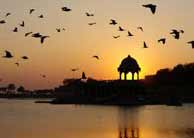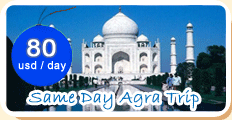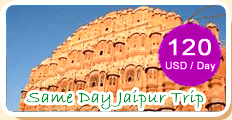
Jaisalmer Tour

 Its like straight out of an Arabian Nights fable. The name Jaisalmer induces a dramatic picture of utter magic and brilliance of the desert. The hostile terrain not with standing the warmth and colour of people is simply over whelming. One of the main draws is the daunting 12th century Jaisalmer Fort. The beautiful havelis which were built by wealthy merchants of Jaisalmer are yet another interesting aspect of the desert city. And you can let your eyes caress the sloppy sand dunes while you ramble your way in a camel safari. The desert citadel is truly a golden fantasy in Thar Desert. Bhatti Rajput ruler Rawal Jaisal, after whom the city finds its name, founded Jaisalmer in 1156.
Its like straight out of an Arabian Nights fable. The name Jaisalmer induces a dramatic picture of utter magic and brilliance of the desert. The hostile terrain not with standing the warmth and colour of people is simply over whelming. One of the main draws is the daunting 12th century Jaisalmer Fort. The beautiful havelis which were built by wealthy merchants of Jaisalmer are yet another interesting aspect of the desert city. And you can let your eyes caress the sloppy sand dunes while you ramble your way in a camel safari. The desert citadel is truly a golden fantasy in Thar Desert. Bhatti Rajput ruler Rawal Jaisal, after whom the city finds its name, founded Jaisalmer in 1156. On advice of a local hermit Eesaal he chose the Tricut Hills as his new abode abandoning his vulnerable old fort at Luderwa just 16 kilometres northwest. In Medieval times, its prosperity was due to its location on the main trade route linking
India to Egypt, Arabia, Persia, Africa and the West. The Bhatti Rajput rulers lined their coffer with gains from traditional taxes on passing by caravans and sometimes through illicit gains by rustling cattle.
Jaisalmer Fort
An apt description of the Jaisalmer fort, one of the finest in the country but one which looks rather incongruous given the desolation around it. Located bang in the middle of the Thar desert (literal meaning abode of the dead), it rises like a mirage from the sands, with its huge turrets pointing skywards. Built in 1156, Jaisalmer is the second oldest of Rajasthan's major forts after Chittorgarh. Constructed by Raja Jaisal, who was searching for a new capital as the earlier one Lodurva was too vulnerable to invasions, he built the fort and the city surrounding it, thus fulfilling Lord Krishna's prophecy in the Mahabharata
NATHMAL JI KI HAVELI
Nathmal Ji ki haveli was commissioned to serve as the residence of Diwan Mohata Nathmal, the then Prime Minister of Jaisalmer. Maharawal Beri Sal commissioned the construction of this Haveli. The architects of this haveli were Hathi and Lulu who happened to be brothers. There is a very interesting story regarding its construction. It is said that the two brothers started building different facets of haveli simultaneously. In those days there were no such instruments, which could keep a track on continuity and thus when this building came up finally it had irregular shape.
PATWON-KI-HAVELI
The five-storied Patwon ki Haveli is the largest of its kind in Jaisalmer, Rajasthan, India. Patwon ki haveli is one of the most elaborate and fascinating mansions in Jaisalmer that entices you with its hypnotic charm.
Located on a narrow lane in the main Jaisalmer city, Patwon ki haveli was constructed by Guman Chand Patwa and his five sons. Guman Chand was a famous trader of his times and dealt in gold, brocade and silver.
SALIM SINGH KI HAVELI
Salim Singh Ki haveli that stands in mute testimony to the splendorous Jaisalmer past towards the eastern end of Jaisalmer city. This stately Jaisalmer haveli with its stunning blue cupola roof is resplendent with exquisite stone carvings, screen windows and exotic murals.
The intricately chiseled brackets on the walls of Salim Singh ki haveli speak volumes about the love for detail and beauty among the artisans of those days. The sheer lavishness of extensive corridors, massive rooms and hallways weaves a bewitching spell on you.
DESERT NATIONAL PARK
The Desert National Park of Jaisalmer is a true reflection of the ecosystem and flora and fauna of the Thar Desert. Founded in 1980, it is spread over an area in excess of 3150 sq km and is probably the largest park of India. Due to a minimal leaf cover the Desert Park supports less of herbivorous animals, camels being an exception to this. The topography of the Park also includes less than 20 % of sand dunes which has compact salt lake bottoms and craggy rocks. The rich flora of the forest consists of palm, salai, dhok and ronj trees.
WOOD FOSSIL PARK
This 300 year old Haveli of Jaisalmer's Prime Minister to Maharaja Rawal Gaj Singh Salim Singh, has a beautiful blue cupola roof with superby carved brackets in the form of peacocks. This extraordinary mansion in yellow stone is covered with intricate carvings and has an elaborate projecting balcony on the top storey. The mansion is one of the most notables of the array of havelis.
AKAL FOSSIL PARK
Spread over 21 hectares, the Akal Wood Fossil Park is a unique experience. The reserve or park has been dated approximately to be 180 million years ago. The whole area is covered with huge fossilized tree trunks, one of which is 7 m by 1.5 m and ancient sea shells throwing light on the ancient geology of the state. Under the archeological department, further excavations are underway to bring to light more fossils.
GADSISAR LAKE
This tank outside the city walls, once held the town's water supply, and, befitting its importance in providing precious water to the inhabitants of this arid city, is surrounded by small temples and shrines. A wide variety of waterfowl flock here in winter. The tank was built by Maharaja Gadsi Singh, taking the advantage of a natural declivity that already retained some water.
GYAN BHANDAR
Gyan Bhandar, a library founded in 1500 A.D. by Acharya Maharaj Jin Bhadra Suri. This small underground vault houses priceless ancient illustrated manuscripts, some dating from the 11th century. Other exhibits include astrological charts and the Jain version of the Shroud of Turin: the Shroud of Gindhasuri, a Jain hermit and holy man who died in Ajmer. In a small locked cabinet are the images of Parasnath made of ivory and various precious stones including emerald and crystal. There are plans to shift the library outside the present location within the Jain temple so it can be visited.
HAVELI MUSEUMS
Several owners of private havelis and the Department of Archaeology have taken over the task of preserving the work, murals, wall paintings and art treasures in most of the noted havelis. Of special significance are the painted murals in 'Patwari ki Haveli' and its specially polished pillars supporting a 5-storey high ceiling. 'Salim Singh Ki Haveli' has an arched blue roof and a surfiet of peacock shaped brackets.
JAIN TEMPLES
Jain Temples situated in the Jaisalmer Fort are a must visit site in Jaisalmer, Rajasthan. You will find these temples to be very old and high pilgrimage as well as archeological value attached to them. These are a group of Jain temples dating back 12th and 15th centuries and are dedicated to various Jain Tirthankars (Hermits). On the walls of the temples, you can find animal & human figures, carved in famous Dilwara style.
TAZIA TOWER, JAISALMER
The delicate pagoda like Tazia Tower rises from Badal Mahal (Cloud Palace). Rising in its five-tiered splendor, with each storey graced by a delicately carved balcony, the tower is of historical significance. Muslim craftsmen built it in the shape of a Tazia and gifted to their royal patron. Tazias are ornately decorated bamboo, paper and tinsel replicas of a bier carried in procession during Muharram.
AMAR SAGAR LAKE
Amar Sagar is a small but pretty lake adjacent to a 17th century pleasure palace called the Amar Singh Palace. It was built by Maharawal Akhai Singh (reigned 1722-61) in honour of one of his predecessors Amar Singh. Next to the palace are pavilions with a large jetty leading down to Amar Sagar Lake.
In close proximity to the lake are figureheads of various animals carved in stone. Located nearby are many wells and cenotaphs of the royal family as well as a large garden with a water tank in the middle known inevitably as the Amar Singh Tank. Being an ardent devotee of Shiva Amar Singh had a Shiv temple built in the complex – a tribute to the deity known as the Destroyer among the holy trinity of gods in the Hindu pantheon.
BADA BAGH JAISALMER
Bada Bagh, which literally means 'Big Garden', is located on the Ramgarh road. It was commissioned by Maharawal Jait Singh in the early 16th century and completed by his son Lunakaran after his death.
The site has three different things to watch, a garden, a tank and a dam. In the vicinity itself you will find Govardhan Stambh (pillar). This pillar was constructed to commemorate the construction of the Dam and the tank. In the local dialect the Dam and the tank are known as Jait Bandh and the Jait Sar respectively. It is believed that these are based on the name of the man who constructed them. The Jait Bandh is a dominating structure. It is about 1,200 feet in length and 350 feet in width. If you observe it closely you will notice that this has been built out of solid blocks of stone. The same material has been used for the construction of well as well as the tank.
LODURVA JAISALMER
Lodurva is the ancient capital of Bhattis Rajputs and was once a flourishing city but lost most of the splendor when the Bhattis shifted their capital to Jaisalmer. Nevertheless this place is a major tourist attraction and attracts a lot of attention due to ruins of Jain temples. The most mesmerizing experience will be the peacock dance amid exotic Lodurva ruins. Yes, Peacocks are a great pull and they are in plenty here.
Lodurva is also known for its Jain temples. The temples are made of bright yellow sandstones. Though in ruins, the splendors of these Jain temples are clearly visible. You will find temple walls decorated with the pictures of Lord Parsvanath, the 23rd Jain Tirthankar. The beautiful Jaali works make these temples a piece of marvel. You will notice the splendid and dominating arch in the main temple building. These arches are typical of the Dilwara style of temple architecture.
KHURI
Join a camel caravan that begins at Jaisalmer and traverse Rajasthan sands in style to the Khuri village, located at a distance of 42 kilometers from the main Jaisalmer City.
Famous for the Khuri sand dunes, the Khuri village accords you a warm traditional greeting and shows you all that is real and glorious about Rajasthan.
Feast your eyes on artistic fiestas that glamorize golden Jaisalmer sands with colors and ethnic charm. Colorful frescoes of animals, geometrical patterns, bird figures and other interesting patterns that adorn the mud walls of Khuri huts, create romantic vistas with their straw thatch-roofs
SAM SAND DUNES
Sam dunes are also the most picturesque spot around Jaisalmer, and perhaps the whole of western Rajasthan. Sitting there in the evening with the sun setting, listening to the ballads of the legendary lovers Moomal and Mahendra (see Moomal Ki Meri for details) on the jew's harp or the narh (a traditional musical instrument), you might feel that time has come to a grinding halt. The silken smooth sands of Sam look like a tale out of the Merchant of Venice and camel safaris are much in vogue here. An overnight trip to the area is a must if you really want to enjoy all the sights and sounds, the ruins and the temples. Sleeping out in the open, stretched out on the sands while facing the twinkling sky is an out of the world experience. Many a tourist has fallen in love with the haunting beauty of the dunes – there is a definite aura of romance about it.
























